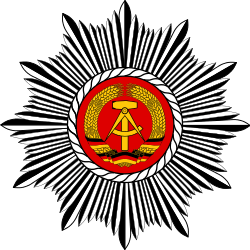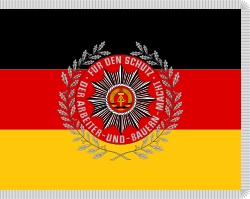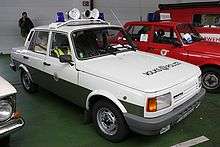Volkspolizei


The Volkspolizei – full official name: the Deutsche Volkspolizei (German People's Police), abbreviated to DVP or VP, and colloquially known as the VoPo – was the national police force of the German Democratic Republic (East Germany). The Volkspolizei was responsible for most law enforcement in East Germany; however, its organisation and structure were such that it could be considered to be as much a paramilitary as a civilian police force. The VP was equipped with armoured personnel carriers and artillery, and its recruits received military training.
History
The Volkspolizei was effectively founded just following World War II, when the Soviet Union established central police forces in the regions of Germany it occupied (in violation of the agreements at the Yalta Conference and the Potsdam Conference). The SVAG approved the arming of community-level police forces on 31 October 1945.
Organization
The Volkspolizei executed traditional police duties such as investigation and traffic control. The Volkspolizei transferred most of their reports to the Ministry of State Security (MfS) and the high density of MfS informants in East Germany, especially in the forces, meant that every police action and investigation could be monitored as besides the official MfS liaison-officer (VO-Verbindungsoffizier), the MfS had agents in nearly every police unit.
The Volkspolizei was a national police force and was directly administered by and subordinate only to the Ministry of the Interior.
Rather than the civil service status that West German police enjoyed, each Volkspolizist had a personal contract with the government. The monthly salary was above the average income.
Main administration of the Volkspolizei

The Volkspolizei was administered by the Ministry of the Interior. The overall commander was the First Deputy Minister of the Interior and Chief of Police (Erster Stellvertreter des Ministers und Chef der Deutschen Volkspolizei). His section was subdivided into five departments:
- Criminal Investigation Department (Hauptabteilung Kriminalpolizei)
- Railway Police Department (Hauptabteilung Transportpolizei)
- Registration Department (Hauptabteilung Pass- und Meldewesen)
- Traffic Police Department (Hauptabteilung Verkehrspolizei)
- Uniformed Police Department (Hauptabteilung Schutzpolizei)
The standby units of the Volkspolizei, that were used for crowd control and anti-riot missions, that is the Kasernierte Einheiten, was administered by the Deputy Minister of the Interior and Chief of the Administrative Center (Stellvertreter des Minister und Chef der Hauptinspektion).
Regional commands
- Berlin Presidium of the People's Police (Präsidium der Volkspolizei)
- Eight police inspectorates (Volkspolizei-Inspektionen)
- River Police Inspectorate (Wasserschutzpolizei-Inspektion)
- Fourteen district commands—one per East German District, excluding Karl Marx Stadt.
- Area Command of the Volkpolizei in Karl-Marx-Stadt (today Chemnitz) to protect the state enterprise of Wismut AG.
Leadership
- Minister of the Interior (Minister des Innern)
- Karl Steinhoff (1949–52)
- Willi Stoph (1952–55)
- Chief of the German Volkpolizei (Chef der deutschen Volkspolizei)
- Kurt Fischer (1949–50)[1]
- Karl Maron (1950–55)[1]
- Minister of the Interior and head of the German People's Police (Minister des Innern und Chef der deutschen Volkspolizei)
- Karl Maron (1955–63)
- Friedrich Dickel (1963–1989)
- Lothar Ahrendt (1989)
Recruitment
Recruitment to the Volkspolizei required at least ten years of education, vocational training (see education in East Germany), military service, and a history of political loyalty.
Upon joining, a recruit would take a five-month course at the Police Academy (VP-Schule). The schedule contained political education, police law, criminal law and procedures, and military-style fitness training. Afterwards the recruit completed a 6-month practical internship.
The reasons Volkspolizei officers gave for joining the force were a desire to work with people, idealism, family tradition, belief in the system and the wish to serve one's country.
Training



From 1962, the Volkspolizei had its own school in Berlin-Biesdorf which trained around 3,500 officers up to 1989. There were several other schools. The Kasernierten Einheiten (barracks units) had their own training facilities. Officers were initially trained in the army ground forces, from 1963 at the Officers' school and from 1971 to the officers' school in Dresden-Wilder Mann.
- Fachschule des MdI "Heinrich Rau" - College of MdI "Heinrich Rau", Radebeul
- Fachschule des MdI, „ Wilhelm Pieck “ - College of the MdI, "Wilhelm Pieck", Aschersleben
- Hochschule der VP — University of the VP, Berlin-Biesdorf (Cecilienstraße)
- Humboldt-Universität zu Berlin /Sektion Kriminalistik — Humboldt University Berlin / Criminalistics Section
- Offiziershochschule Bereitschaften "Artur Becker", Dresden (Officer school for standby units, "Artur Becker", Dresden (now the headquarters of the State Criminal Office Saxony)
- Schule für Abschnittsbevollmächtigte (school for the section represented), Wolfen
- Schule des Nachrichtenwesens (School of Communication), Dommitzsch
- Spezialschule des MdI für Diensthundewesen — Special School for service dogs, Pretzsch (Elbe)
- Spezialschule des MdI für medizinische Dienste (im Bezirk Magdeburg ) - Special School of medical services (in the district of Magdeburg)
- Transportpolizei-Schule (Transport Police School), Halle (Saale)
- Verkehrspolizei-Schule "Hans Beimler" (Traffic Police School), Magdeburg
- VP-Schule "Ernst Thälmann", Neustrelitz (since 1984 central service similar school)
The Volkspolizei had approximately 80,000 full-time police officers and 177,500 volunteers.
With the accession of East Germany to the Federal Republic on 3 October 1990, authority over the police went to the newly created federal jurisdiction. About forty percent of the Volkspolizei employees had to leave the service.
Effectiveness
The National People's Army and the Volkspolizei erected the Berlin Wall in 1961. The leadership declared it would protect the country against what they represented as the negative elements of West German and NATO societies, particularly fascist sympathisers (the wall was officially called the "anti-fascist protection rampart") and help on the way to a crime-free workers' state.
Oath
The official oath that all Volkspolizei officers swore was:[2]
| Original German | English translation |
|---|---|
| Ich schwöre
meinem sozialistischen Vaterland, der Deutschen Demokratischen Republik und ihrer Regierung allzeit treu ergeben zu sein, Dienst- und Staatsgeheimnisse zu wahren und die Gesetze und Weisungen genau einzuhalten. |
I swear, to be loyal to my socialist fatherland, the German Democratic Republic and its government at all times, to keep official and state secrets, and to strictly obey laws and instructions. I will unswervingly strive to fulfill my official duties conscientiously, honestly, courageously, vigilantly and with discipline. I swear, that I will, without reservation, under risk of my life protect the socialist social, state and legal order, the socialist property, the personality, the rights and the personal property of the citizens against felonious attacks. If I nevertheless break this, my solemn oath, I shall be confronted with the punishment of the laws of our republic. |
Uniforms
With the exception of the Kasernierte Volkspolizei, whose grey-green uniforms follow the style of the East German National People’s Army (Nationale Volksarmee - NVA), all Volkspolizei services wore the same basic uniform adopted in 1956 when it was officially established. There were various kinds of uniforms, worn according to the work or social situation and differing in material for summer or winter wear. Most uniforms — service, semi-dress, and parade — are gray-green but the transport police wore dark blue. The better quality and texture of the cloth in officers' uniforms distinguished them from the uniforms of enlisted personnel. The field and service uniforms became normal attire in garrison and for most other duty activities.
The basic categories of uniforms were field, service, semi-dress, and parade.
Field uniforms (Felddienstuniform) were for only the Kasernierte Volkspolizei. The field uniform consisted of the NVA's service uniform. The uniform was worn with a field cap, service cap, or steel helmet; high black boots; and a leather belt with vertical web shoulder suspenders. In the winter, a quilted stone-grey padded suit without a camouflage pattern is worn over the service uniform. The winter uniform also includes a fur pile cap or a steel helmet, boots, knitted grey gloves, belt, and suspenders.
The service uniform (Dienstuniform) was a summer service uniform for officers with a bloused jacket, worn without a shirt, trousers, and a visored service cap. The winter service uniform featured a jacket had four large patch pockets with button-down tabs, worn with a black belt, the service cap, breeches, shirt, tie, belt, and high boots are provided for officers and NCOs. For winter, there also is a long, heavy, belted overcoat.
The semi-dress uniform (Ausgangsuniform), except in details, was the same for all ranks and was worn on off-duty or off-post occasions. It included the service cap, jacket, long trousers, and black low-quarter shoes. The single-breasted jacket was worn without a belt, with a white or grey-green shirt and a green tie. Officers were allowed to wear the jacket with a white shirt. During periods of warm summer weather, either the shirt and tie or the jacket may be omitted. For a while a double-breasted jacket could be worn as optional wear by officers and warrant officers.
The parade uniform (Paradeuniform) for officers was the semi-dress jacket worn with all awards and decorations, breeches and riding boots, steel helmet or police shako (Tschako) from 1950 to the late 1960s, white shirt, green neck-tie, and a ceremonial dagger on the left side, fastened to a silver-grey parade belt. Officers in guards of honour carry sabres. In winter, overcoat, scarf, and gloves were worn.
The type of work uniform (Arbeitsuniform) worn was governed by seasonal considerations and weather. Generally, reconditioned items of service clothing; field, semi-dress and winter padded uniforms; some dyed black, were issued for all types of fatigue and maintenance details. Coveralls are also used by the lower ranks, especially heavy vehicle and flying personnel. Officers in technical branches supervising fatigue details wear a laboratory-style smock.
Other types of Volkspolizei uniforms existed. High-ranking officers occasionally wore white uniforms, or at least a white jacket, and staff officers were supplied with staff service uniforms. Women had their own uniforms consisting of jackets, skirts or slacks, blouses, caps, boots or pumps, and other appropriate items in accordance with the season and the occasion. Traffic police, motorcyclists, armoured vehicle personnel, and others have special items of apparel.
Waffenfarben
Volkspolizei uniform initially had green waffenfarben, but later reverted to white except for the transport police who wore blue. The uniform of the Kasernierte Volkspolizei is distinguished from that of the NVA ground force and Air Defence Force by a green armband with large silver letters identifying the wearer's affiliation.
Equipment




 Police Boats
Police Boats Barkas B 1000s
Barkas B 1000s Robur LO 2002 trucks
Robur LO 2002 trucks
See also
References
- 1 2 Bessel, Richard (2003). "Policing in East Germany in the wake of the Second World". Crime, History & Societies. 7 (2). Retrieved 28 April 2013.
- ↑ http://www.ddr-geschichte.de/Politik/Staatsorgane/Polizei/polizei.php Die Deutsche Volkspolizei (DVP)
![]() This article incorporates public domain material from the Library of Congress Country Studies website http://lcweb2.loc.gov/frd/cs/.
This article incorporates public domain material from the Library of Congress Country Studies website http://lcweb2.loc.gov/frd/cs/.
External links
| Wikimedia Commons has media related to Volkspolizei. |
- Official Site of the German Police
- EAST GERMANY - A Country Study (based on information from the Library of Congress)
- The Democratisation of the Police (With Reference to the Brandenburg Police) by John Chivers
- IG Deutsche Volkspolizei, in German
- Volkspolizei page, at www.polizeiautos.de
![]() This article incorporates public domain material from the Library of Congress Country Studies website http://lcweb2.loc.gov/frd/cs/.
This article incorporates public domain material from the Library of Congress Country Studies website http://lcweb2.loc.gov/frd/cs/.